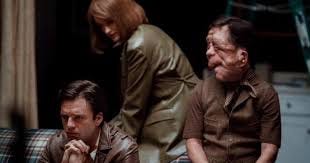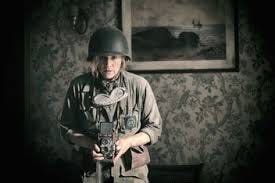Negative Thoughts
My thoughts on Azrael, A Different Man and Lee
As the action-horror hybrid Azrael opens, we learn from expository title cards that sometime in the near-future, the Rapture has occurred and those left behind have formed a religious cult that, having decided that speech was a sin, now lives a mute existence in the woods by having their vocal chords removed so that they cannot talk. As great as this sounds, there are evidently some among them who aren’t entirely thrilled with this existence and two of them, Azrael (Samara Weaving) and boyfriend Kenan (Nathan Stewart-Jarrett), have decided to flee the group and go off on their own. Alas, Kenan is not the brightest bulb and after lighting an easily detected fire where they have stopped to rest, they are quickly recaptured. Azrael is brought back to the camp where leader Josephine (Kateriina Unt) ties her to a chair and leaves her as a sacrifice to the bizarre blind vampire creatures who live deep in the wilderness and who are attracted by the scent of blood. Alas, it appears that Azrael is the only member of humanity with a functioning IQ as she, despite being bound up and with her legs slashed to attracted the beast, manages to escape her bonds and flee, kicking off a movie-long chase in which she tries to evade both the monsters and the other cultists in her desperate bid for freedom.
Although the initial premise may make Azrael sound relatively promising, it is soon undone by startlingly faulty execution on practically all levels. For starters, the conceit of telling a genre story sans dialogue is not exactly a fresh premise and while the script by Simon Barrett manages to come up with a reasonably solid excuse for the gimmick, it never makes much of it. What is worse, Barrett evidently spent so much time trying to justify the premise that he failed to include any of the other elements that might have helped to sell it—we never get a sense of exactly how long this has been going on (the cultists are living a seemingly shabby existence in the woods but their jackets don’t seem too far removed from the racks at L.L. Bean, their guns have plenty of ammo and their trucks are gassed and ready) and there is one major development about halfway through that seems poised to spin the narrative off in a potentially fascinating direction, only to frustratingly abandon it almost immediately afterwards. Although director. E.L. Katz is able to conjure up the occasionally interesting visual flourish, with the aid of cinematographer Mart Taniel, the extended action beats are confusingly staged—and not in a good way—and soon grow tedious, despite the liberal amounts of gore spilled along the way. The one aspect of the film that does work is the striking presence of Weaving in the lead but even though she is as about as convincing as anyone could possibly be in these circumstances, watching her as she goes about slaughtering her oppressors cannot help but invite comparisons to her similar role in the infinitely more entertaining Ready or Not. She may be the best thing about Azrael but not even she can rescue it from being anything more than a pointless, blood-soaked mediocrity
.In A Different Man, the often discomfiting dark comedy from writer-director Aaron Schimberg, Sebastian Stan plays Edward, an aspiring New York actor who suffers from facial neurofibromatosis, a disfiguring condition that seems to limit his career to appearing in corporate PSA videos evidently designed to educate “normal” employees about working alongside those with disabilities so that they can feel better about themselves for doing so. This is not especially great for his sense of self-worth, so much so that when a new neighbor, aspiring playwright Ingrid (Renate Reinsve) shows him some genuine kindness, he doesn’t know how to respond. With nothing to lose, Edward agrees to take part in an experimental procedure designed to help people like him and it works astonishingly well—his disfigurements slough away so completely (and in appropriately goopy fashion) that not only is he handsome enough to appear in a Marvel movie (or at least get a barroom blowjob on his first night out), his former neighbors no longer recognize him when he claims to be Guy, a distant relation of Edward’s, who he says committed suicide.
Thanks to his new look, Edward finally enjoys the superficial trappings of life as a handsome lad—he becomes a success in the world of real estate, where his newly-found image and sense of self-confidence prove to be assets and acquires a sexy girlfriend and a fabulous apartment. However, his previous existence literally calls back to him one day when he passes by a small local theater and discovers that Ingrid is preparing to stage a play she has written inspired by her time with Edward and is in the process of casting the key role. On an impulse, he tries out to play himself and while Ingrid, who does not recognize him, has some qualms about casting a non-disabled person in the part, she does hire him and the two even become lovers to boot. However, Edward is no longer that Edward anymore, both physically and emotionally, and finds it inexplicably different to find his character, as it were. Matters are complicated further by the arrival of Oswald (Adam Pearson), who is another actor with the same condition Edward once had but who did not let it destroy his confidence or sense of self-worth. His cheerful demeanor not only subverts conventional societal attitudes towards the disabled but underscores the melodramatic cliches that the well-meaning Ingrid has baked into her play, inspiring her to take it in a new direction that ends with Oswald now in the lead and with Edward reduced to a mere cameo in the retelling of his own life, sending him off on a new and even darker spiral of self-loathing that he can no longer excuse to himself as being because of how he look.
As he did in his previous film, Chained for Life, Schimberg is telling a story about contemporary societal attitudes towards disability that offers no easy answers and which leaves no one off the hook, not those able-bodied people who look at them with either barely concealed horror or borderline condescending pity or those disabled people who are all too willing to embrace the cliched attitudes that society has held towards them instead of daring to challenge them. This is, to put it mildly, a fairly risky approach for a filmmaker to attempt, especially when told as jet-black comedy, and is the kind that, if not done exactly right, runs the risk of potentially being deeply offensive. To his credit, Schimberg doesn’t hesitate or pull any punches in how he tackles both the story and the character of Edward and while his refusal to reduce the story to a simple story with an obvious moral lesson and a central character whose obvious issues are neatly resolved in a happy, or at least conventionally tragic, manner in the final scenes may frustrate or upset some viewers, others are liable to find it strangely liberating.
Perhaps the most daring conceit on display comes when Edward goes through his incredible transformation, acquires his conventional good looks and discovers to his profound disappointment that the sort of catharsis one might have expected from such a change never quite arrives. Although now ostensibly handsome and successful, his innate sense of self-loathing remains unchanged and his encounters with the always-friendly and gregarious Oswald—the kind of person he probably wished he could have been in his prior life—drive him to madness. This is delineated brilliantly by the performance from Stan, who has probably never been better than he is here. The film takes his character to some pretty dark areas and Stan fearlessly embraces them all, remaining compelling even when his monstrousness shifts from the physical to the emotional with a performance that forces viewers to confront their own attitudes without offering them simple answers or easy outs. Needless to say, A Different Man is probably not for everyone and moviegoers not quite on Schimberg’s audacious wavelength are liable to be greatly put off by it but those looking for something both challenging and morbidly amusing are advised to seek this one out.
As the beginning of Lee, the biopic on the life of famed war photographer Lee Miller, we see Miller (Kate Winslet), an American former model turned amateur photographer gamboling through Thirties-era Europe, having topless lunches with her bohemian friends (played by Marion Cotillard and Noemie Merlant, flirting with British artist Roland Penrose (Alexander Skarsgard) and willfully ignoring the growing storm clouds of war that are gathering. When World War II does eventually break out, Lee, out of a desire to feel useful, offers her services to Vogue editor Audrey Winters (Andrea Riseborough) as a photographer and war correspondent for the magazine. Although her efforts are at first disdained by military brass, who refuses to allow her into press briefings, let alone the front line, because of her gender, she perseveres and captures indelible images of such sights as the aftermath of the London Blitz, the liberation of Paris and the horrors hidden behind the walls of the Nazi concentration camps—in perhaps her most notorious work, she and photojournalist colleague David E. Scherman (Andy Samberg. . .yes, that Andy Samberg) gain access to one of Hitler’s apartments and take a picture of Miller taking a bath in Der Fuhrer’s tub.
Kate Winslet has been trying to get a biopic on the life of Miller off the ground for about a decade now and it is easy to understand why—a life like hers (she passed away in 1977) was so remarkable that it all but screams out for cinematic treatment. Therefore, it is all the more bewildering that Lee takes such a potentially fascinating story and somehow renders it dramatically inert. In recounting her story, screenwriters Liz Hannah, Marion Hume and John Collee (adapting the biography written by her son, Anthony, who only became aware of her wartime exploits after her passing) have utilized a clumsy and-then-this-happened that feels more like a high school essay written by someone who has largely cribbed from her Wikipedia entry and which further shoots itself in the foot by surrounding these episodes with an unnecessary framing device in which a now-old Miller is being grilled by an interviewer (Josh O’Connor) that builds to a couple of final twists that are meant to be incredibly emotional, I suppose, but which fall painfully flat. In perhaps the most frustrating part of the film, for example, the film introduces a confrontation between Miller’s determination that the world bear witness to the nightmarish imagery that she has seen and artfully captured with her camera and the Vogue editorial board’s belief that their readers won’t stand for such a raw and unvarnished look of those horrors, only to pretty much abandon it after one scene, save for a brief follow-up during the title cards that turn up at the end.
Making her directorial debut, celebrated cinematographer Ellen Kuras has made a movie that looks good but which just plods along without any real life or flavor to it. She has a pretty impressive supporting cast on hand but with the exception of the bizarre and occasionally distracting presence of Samberg (who is not cracking jokes or anything but who nevertheless feels out of place), they prove to be largely forgettable and when you somehow manage to render such sparky performers as Cotillard, Riseborough and Merlant mostly inert, you are clearly doing something wrong. As for Winslet, she is really good her and whatever life the film manages to generate is almost due entirely to her efforts. Her years of work trying to get this film made clearly steeled her resolve to do honor to Miller and her legacy and it shows. Watching her shift from a woman content to spend her days drinking and screwing around to someone profoundly changed by the things that she saw and photographed is a reminder, not that one is needed at this point, that Winslet is one of our strongest actresses. However, not even her considerable efforts can do much to save Lee from being just another forgettable biopic, the kind of story that might have been told more fruitfully through a more straightforward documentary approach.




